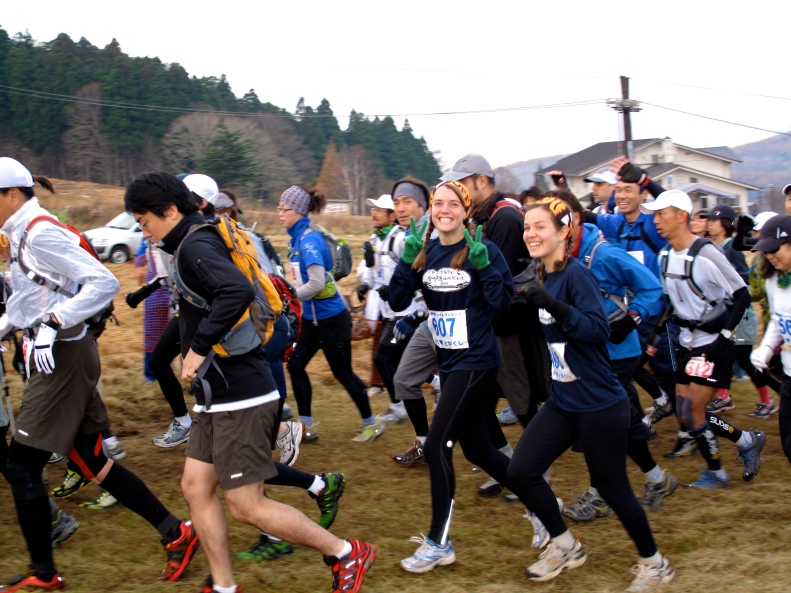November in the Japanese Alps is a miserable time. Post-Fall colors, pre-ski season. There’s nothing really to do but soak in the onsens and wait for snow. Or you could sign up for an ultra-marathon, disregard the details because they’re written in Japanese, and drag your friend into it too. It will be hard. You’ll be surprised by the two mountains (mountains!) you peak during the run, your knees will protest as you bound and boulder hop down the second mountain, but you might also stay at an extremely cute Japanese guest house the night before the race where you will eat the best miso soup of your life. You’ll wake-up early to the soft footfalls of the friendly proprietor and stumble down the narrow stairs of the guest house in the dark for a pre-race breakfast of said amazing miso soup. Every kilometer of that race will be worth the soup that started out your day. You’ll run farther then than you’ve ever run, you’ll find something in you that you didn’t know existed—an inner strength that is beyond your body. And even when you finish and your stomach protests even the notion of food, you will reflect fondly on that 4am breakfast so many hours ago. Thus is the power of miso soup (well, and distance running, but man they are a dynamic combination!).
Nothing fills the corners like miso soup. It’s both clarifying and deeply satisfying. It is the epitome of umami, the elusive 5th flavor. And with so many types of miso, the variance in flavor of miso soup is vast. So how many types of miso are there? I often compare miso in Japan to cheese in France. Each region has their own special miso reflecting the qualities of that place.
My favorite miso is hatcho-miso, it’s rich and looks very much like fudge! If you’re new to miso and not quite decided on the flavor yet, genmai-miso or mugi-miso (both mixed with whole grains like brown rice and barley) yield a more subtle flavor. Aka-miso (red miso) is also a great all-around miso with a slightly richer flavor than the grain-mixed misos. Saikyo miso, or other white miso, is very light and sweet in flavor, and although I don’t make it too much myself, I believe it was the mighty miso that I had the morning of my race in Japan.
Miso is often falsely thought of as soup broth, but adding miso to plain hot water doesn’t leave you with a very appetizing soup. You need to make some broth, which in Japanese is called dashi. If you get into the habit, having some dashi on hand is really useful for adding to all manner of sauces for extra flavor instead of water. A jar of dashi in the fridge might resemble some sort of science of experiment, but it can keep for at least a week there and that way you’re ready for miso soup in the time it takes to (nearly) boil water.
There are lots of ways to make dashi. Most traditional methods include shavings of smoked katsuo-bushi (a dried fish product we call “bonito” in English). It’s tasty stuff, but, I usually make a vegetarian version. My broth always includes ma-kambu which is just dried kelp. It adds that rich ocean flavor that is quintessentially miso soup to me. Then I add flavor either with dried shiitake mushrooms or kampyo. You are probably quite familiar with shiitake’s, but kampyo could be new a one. I came to love kampyo while living in Japan— it’s a very versatile, low maintenance pantry item. Kampyo is dried gourd which is sold as a long, white sort of tubular ribbon. It has a great salty, vegetable flavor, perfect for making stock! You can find dried kombu, shiitake and kamyo in most grocery stores that show some dedication to stocking Japanese ingredients. In the Bay Area, I’ve found a great selection of these items (and other Japanese pantry items) at the Berkeley Bowl.
Recipe: Miso Soup 4 people
1 six inch by 4 inch piece of kombu (dried kelp)
1 handful of dried shiitake mushrooms or a twelve inch piece of kampyo
4 heaping tablespoons of hatcho miso (or your choice of miso)
a handful of slivered onion (green onions, leeks, red, white… just enough for a flavor)
To make the dashi, soak your kombu and shiitake or kamyo in about 4 cups of cold water for at least 2 hours on the countertop, or up to a week in the fridge. When it’s time to make soup, set aside the kombu/shiitake/kampyo (and either save for pickling or discard) and slowly heat the dashi.
When the water is hot, but not boiling, it’s time to add the miso. Adding miso to boiling water not only jeopardizes the health benefits of miso, but it also seems to deaden the flavor. Place 4 heaping tablespoons of miso in a sieve (there are even specialty miso sieves available) and force the miso through the sieve while it is immersed in the dashi. This makes quick work of evenly distributing the miso and combining it with the dashi.
At the last minute, add the onion to the soup, and cover to let sit for just a few minutes while you prepare the bowls. If you’re adding anything to your soup, place it in the bottom of your soup bowl (some grilled or blanched vegetables perhaps?). Ladle hot miso soup into the bowls. Now you can eat the best, most simple meal ever invented!


Pingback: 南瓜 Kabocha (Japanese pumpkin) « rice seasons